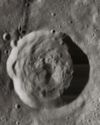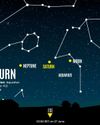
Neptune was the first planet to have its existence predicted by mathematical calculations before it was actually seen through a telescope on 23 September 1846. Irregularities in the orbit of Uranus led French astronomer Alexis Bouvard to suggest that the gravitational pull from another celestial body was responsible. German astronomer Johann Galle then relied on subsequent calculations to help spot Neptune. Astronomer Galileo Galilei had sketched the planet, but he mistook it for a star due to its slow motion.
Only one mission has flown by Neptune – Voyager 2 in August 1989 – meaning that astronomers have done most studies using ground-based telescopes. There are still many mysteries about the cool blue planet, such as why its winds are so speedy and why its magnetic field is offset. While Neptune is of interest because it’s in our Solar System, astronomers are also interested in learning more about the planet to assist with exoplanet studies. Specifically, some astronomers are interested in learning about the habitability of worlds that are somewhat bigger than Earth.
Those closer to Earth’s size are called ‘super-Earths’, while those that are closer to Neptune’s are ‘mini-Neptunes’. However, there’s some debate about those terms, given that today’s telescope technology doesn’t make it possible to view how much atmosphere is on those planet types, making it difficult to make a distinction.
This story is from the Issue 146 edition of All About Space UK.
Start your 7-day Magzter GOLD free trial to access thousands of curated premium stories, and 9,000+ magazines and newspapers.
Already a subscriber ? Sign In
This story is from the Issue 146 edition of All About Space UK.
Start your 7-day Magzter GOLD free trial to access thousands of curated premium stories, and 9,000+ magazines and newspapers.
Already a subscriber? Sign In

LONG AGO, A LAKE ON MARS MAY HAVE BEEN SPRAWLING WITH MICROBES
Curiosity discovered manganese oxide in bedrock in a Martian region that may have been a shoreline billions of years ago

MOON TOUR HELL
Finding this fascinating crater isnt as hard as its name suggests...

THIS MONTH'S PLANETS
Most of the planets are tricky targets this month, but our guide will help you locate them

UNIVERSE BEFORE TIME
Could the existence of a mirror-image cosmos before the Big Bang solve some of the biggest mysteries in astronomy?

CLIMATE CHANGE IN THE SOLAR SYSTEM
Alongside Earth, our planetary neighbourhood is changing, but it’s not for the better…

Stars give tiny planets a gravitational 'squeeze' to strip away their atmospheres
A scientist has learned more about the violent processes that rip atmospheres away from planets, finding that squashing and squeezing by a parent star can contribute to this process.

The Milky Way's halo is filled with ‘magnetic doughnuts' as wide as 100,000 light years
The outer halo of the Milky Way is filled with magnetic fields that take the shape of vast doughnuts with diameters ranging from 12,000 to 100,000 light years, with the heart of our galaxy at their centre.

The Pentagon wants the commercial space reserve to support military satellites in orbit
The US Department of Defense is developing a plan to use the ever-growing American commercial space industry for national security purposes.

DOES A COSMIC 'GLITCH' IN GRAVITY CHALLENGE ALBERT EINSTEIN'S GREATEST THEORY?
Gravity changes once you reach a cosmic scale

DEEP SKY CHALLENGE : STELLAR TREASURES OF THE ARCHER AND SCORPION
Summer skies are stuffed full of amazing objects for your telescope - if you're prepared to stay up late